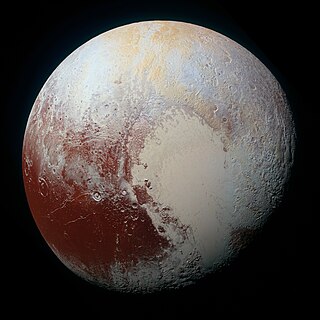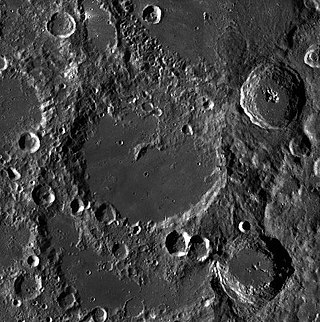
Planetary nomenclature, like terrestrial nomenclature, is a system of uniquely identifying features on the surface of a planet or natural satellite so that the features can be easily located, described, and discussed. Since the invention of the telescope, astronomers have given names to the surface features they have discerned, especially on the Moon and Mars. To found an authority on planetary nomenclature, the International Astronomical Union (IAU) was organized in 1919 to designate and standardize names for features on Solar System bodies.

Karl Theodor Robert Luther, normally published as Robert Luther, was a German astronomer. While working at the Bilk Observatory in Düsseldorf, Germany, he searched for asteroids and discovered 24 of them between 1852 and 1890. Seven times Lalande Prize winner.

Petrarch is a crater on Mercury. This crater is located within the distorted terrain on the opposite side of the planet from the Caloris Basin. It was named after Petrarch, the medieval Italian poet, by the IAU in 1976.

Von Kármán is a large lunar impact crater that is located in the southern hemisphere on the far side of the Moon. The crater is about 186 km (116 mi) in diameter and lies within an immense impact crater known as the South Pole–Aitken basin of roughly 2,500 km (1,600 mi) in diameter and 13 km (8.1 mi) deep. Von Kármán is the site of the first soft-landing on the lunar far side by the Chinese Chang'e 4 spacecraft on 3 January 2019.

Patsaev is a lunar impact crater that lies on the far side of the Moon, to the northeast of the prominent crater Tsiolkovskiy. To the northwest is the smaller crater Lander.
Stokes is an impact crater on Mars, located on the Martian Northern plains at 55.9°N latitude and 188.8°W longitude. It measures approximately 62.74 kilometres (38.98 mi) in diameter and was named after Irish-born physicist George Gabriel Stokes (1819–1903). The crater's name was officially adopted by IAU's Working Group for Planetary System Nomenclature in 1973.
Agnesi is a crater on the planet Venus. It was named after Maria Gaetana Agnesi, an Italian mathematician; Venusian craters are named after notable women. The crater was named by the International Astronomical Union's Working Group on Planetary System Nomenclature in 1991. It is located at 39.4 degrees south and 37.7 degrees east. The crater is 42.4 kilometers in diameter.

Flag crater is a small crater in the Descartes Highlands of the Moon visited by the astronauts of Apollo 16. The name of the crater was formally adopted by the IAU in 1973. Geology Station 1 is adjacent to Flag, at the much smaller Plum crater.

PateraPAT-ər-ə is an irregular crater, or a complex crater with scalloped edges on a celestial body. Paterae can have any origin, although the majority of them were created by volcanism. The term comes from Latin, where it refers to a shallow bowl used in antique cultures.







